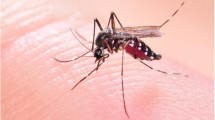Abstract
Density of vectors and development of resistance against insecticides are two important aspects in the control of vector-borne diseases. Here, effect of temperature on different aspects of development of malathion-resistant and susceptible strains of Culex quinquefasciatus was evaluated in the laboratory. Fourth-instar larvae of C. quinquefasciatus were exposed to 37°C, 39°C, 40°C, and 41°C, and their LT50 values calculated. The fourth-instar larvae were subjected to heat for 4 h at 39°C and live larvae were reared until the completion of life cycle. The larvae of malathion-resistant strain were more tolerant to heat than the larvae of malathion-susceptible ones. The difference in mortality between 37°C, 39°C, 40°C, and 41°C of both the strains of C. quinquefasciatus were highly significant. Pupation percentage of heat-exposed larvae of both the strains was higher and delayed than the control ones. The percentage of adult emergence from the heat-exposed larvae was significantly lower than the control. The adult female of malathion-resistant strain showed increased longevity when exposed to heat at larval stage but reverse was true in case of malathion-susceptible. The highlights of the study would help in the management of resistance of mosquito vectors in the tropics where variable climatic condition is observed.




Similar content being viewed by others
References
Ansari MA, Vasudevan P, Tandon M, Razdan RK (2000) Larvicidal and mosquito repellent action of peppermint (Mentha piperita) oil. Bioresour Technol 71:267–271
Bayoh MN, Lindsay SW (2004) Temperature-related duration of aquatic stages of the Afrotropical malaria vector mosquito Anopheles gambiae in the laboratory. Med Vet Entomol 18:174–179
Clements AN (1963) The physiology of mosquitoes, International series of monographs on pure and applied biology. Pergamon, Oxford
Clements AN, Paterson GD (1981) The analysis of mortality and survival rates in wild populations of mosquitoes. J Appl Ecol 18:373–399
Dixit V, Gupta AK, Kataria O, Prasad GBKS (2002) Population dynamics of Culex quinquefasciatus filaria vector in Raipur City of Chhattisgarh State. J Commun Dis 34:193–202
Githeko AK, Lindsay SW, Confalonieri UE, Patz JA (2000) Climate change and vector-borne diseases: A regional analysis. Bull World Health Organ 78:1136–1146
Hemingway J, Karunaratne SHPP (1998) Mosquito carboxylesterases: a review of the molecular biology and biochemistry of a major insecticide resistance mechanism. Med Vet Entomol 12:1–12
Huffaker CB (1944) The temperature relations of the immature stage of the malaria mosquito An. quadrimaculatus Say, with a comparison of the development power of constant and stable temperatures in insect metabolism. Ann Entomol Soc Am 37:1–27
Lassiter M, Apperson C, Roe R (1995) Juvenile hormone metabolism during the fourth stadium and pupal stage of the southern house mosquito Culex quinquefasciatus Say. J Insect Physiol 41:869–876
McDonald G, McLaren IW, Shelden GP, Smith IR (1980) The effect of temperature on the population growth potential of Culex annulirostris Skuse (Diptera: Culicidae). Austral Ecology 5:379–384
Muirhead–Thomson RC (1940) Mosquito behaviour in relation to malaria transmission and control in the tropics. Edward Arnold, London
Patil NS, Lole KS, Deobagkar DN (1996) Adaptive thermo tolerance and induced cross tolerance to propoxur insecticide in mosquitoes. Med Vet Entomol 10:277–282
Rueda LM, Patel KJ, Axtell RC, Stinner RE (1990) Temperature-dependent development and survival rates of Culex quinquefasciatus and Aedes aegypti (Diptera: Culicidae). J Med Entomol 27:892–898
Shelton RM (1973) The effect of temperatures on development of eight mosquito species. Mosq News 33:1–12
Sohn SR (2007) Seasonal prevalence of the Culex pipiens group (Diptera: Culicidae) larvae occurring in a puddle in the basement of an apartment building. Entomol Res 37:95–99
Swain V, Mohanty SS, Raghavendra K (2008) Sunlight exposure enhances larval mortality rate in Culex quinquefasciatus Say. J Vector Borne Dis 45:70–72
Thavaselvam D, Kumar A, Sumodan PK (1993) Insecticide susceptibility status of Anopheles stephensi, Culex quinquefasciatus and Aedes aegypti in Panaji, Goa. Indian J Malariol 30:75–79
Acknowledgements
Thanks are acknowledged to the University Grants Commissions, New Delhi for providing financial assistance to the first author. We also acknowledge the help rendered by Mr. R. S. Sharma, Mr. S.M. Dash of the National Institute of Malaria Research, Delhi, and Mr. T. K. Barik of the Zoology Department, University of Delhi.
Author information
Authors and Affiliations
Corresponding author
Rights and permissions
About this article
Cite this article
Swain, V., Seth, R.K., Mohanty, S.S. et al. Effect of temperature on development, eclosion, longevity and survivorship of malathion-resistant and malathion-susceptible strain of Culex quinquefasciatus . Parasitol Res 103, 299–303 (2008). https://doi.org/10.1007/s00436-008-0969-5
Received:
Accepted:
Published:
Issue Date:
DOI: https://doi.org/10.1007/s00436-008-0969-5




